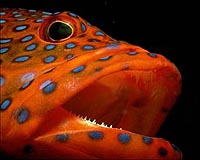| . |  |
. |
Buffalo NY (SPX) Nov 03, 2009 A husband and wife team of American paleontologists has discovered a new species of dinosaur that lived 112 million years ago during the early Cretaceous of central Montana. The new dinosaur, a species of ankylosaur, is documented in the October issue of the Canadian Journal of Earth Sciences. Ankylosaurs are the biological version of an army tank. They are protected by a plate-like armour with two sets of sharp spikes on each side of the head, and a skull so thick that even 'raptors' such as Deinonychus could leave barely more than a scratch. Bill and Kris Parsons, Research associates of the Buffalo Museum of Science, found much of the skull of the newly described Tatankacephalus cooneyorum resting on the surface of a hillside in 1997. Because the skull was 90% complete, it was possible to justify this fossil as a new species. "This is the first member of Ankylosauridae to be found within the Early Cretaceous Cloverly Geologic Formation," said Bill Parsons, who characterized the fossil as a transitional evolutionary form between the earlier Jurassic ankylosaurs and the better known Late Cretaceous ankylosaurs. The skull is heavily protected by two sets of lateral horns, two thick domes at the back, and smaller thickenings around the nasal region. "Heavy ornamentation and horn-like plates would have covered most of the dorsal surface of this dinosaur" said Bill Parsons. "For years, Bill and Kris have been collecting fossils from a critical time in Earth's history, and their hard work has paid off," said Lawrence Witmer, professor of paleontology at Ohio University who was not involved with this study. "This is a really important find and gives us a clearer view of the evolution of armored dinosaurs. But this is just the first; I'm sure, of what will be a series of important discoveries from this team." Parsons also illustrated the dermal armour of this new species based on the theory by Museum of the Rockies paleontologist John R. Horner that there was an outer keratinous sheathing on it as found in modern turtle shells and bird beaks. In his new reconstruction, Parsons suggests that Tatankacephalus exhibited complex and colorful patterns rather than the dull appearance suggested in earlier ankylosaur portraits. "According to Horner's theory, many other dinosaurs also had this kind of sheathing and also may have been diversely colored" said Parsons. As to its name, the broad, short horns on the back of its skull resemble the horns found on a modern buffalo skull and Tatankacephalus loosely translates as 'Buffalo head.' Parsons also noted, "of course any further allusions to the city of Buffalo are completely intentional as well". Share This Article With Planet Earth
Related Links Buffalo Museum of Science Darwin Today At TerraDaily.com
 1,147 fish species threatened with extinction: IUCN
1,147 fish species threatened with extinction: IUCNGeneva (AFP) Nov 3, 2009 More than 1,000 freshwater fish species are threatened with extinction, reflecting the strain on global water resources, an updated global "Red List" of endangered species showed Tuesday. The list by the International Union for Conservation of Nature (IUCN) is the most respected inventory of biodiversity covering more than 47,000 of the world's species. Scientists looked at 3,120 freshwa ... read more |
|
| The content herein, unless otherwise known to be public domain, are Copyright 1995-2009 - SpaceDaily. AFP and UPI Wire Stories are copyright Agence France-Presse and United Press International. ESA Portal Reports are copyright European Space Agency. All NASA sourced material is public domain. Additional copyrights may apply in whole or part to other bona fide parties. Advertising does not imply endorsement,agreement or approval of any opinions, statements or information provided by SpaceDaily on any Web page published or hosted by SpaceDaily. Privacy Statement |